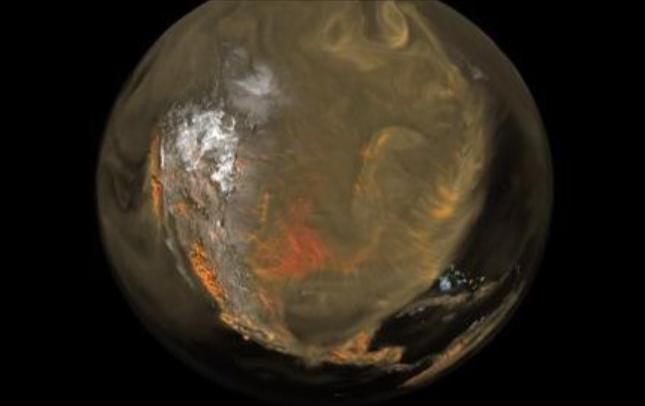Researchers uncovered a significant radiocarbon spike occurring 14,300 calendar years BP (before Present), a discovery made through the meticulous analysis of subfossil trees, according to a groundbreaking study downloaded from the Royal Society Publishing on October 18, 2023. Pinpointed with remarkable precision, this radiocarbon revelation offers unprecedented insights into the oscillations of the global carbon cycle during the Late Glacial epoch.
Innovative Research Methods
The Drouzet chronology, the study’s focal point, is a testament to scientific rigor, presenting a bar diagram that meticulously reports all cross-dated trees, with lighter bar colors indicating correct but weaker matches. The researchers, intriguingly, observed an abrupt drop in 14C age around 14.3 cal kyr BP, a prominent feature of the Drouzet record that defies previous assumptions about radiocarbon age trends. The research delves into the realm of radiocarbon methods, where wood from each annual ring of selected trees was separated and sliced into small pieces, highlighting the painstaking detail involved in radiocarbon analysis.
Contextualizing the Findings
The study cites work, such as that by Bard E in 1998, to contextualize its findings within the broader scientific discourse on radiocarbon’s geochemical and geophysical implications. Skinner LC and Bard E’s work, one of the study’s pivotal references, underscores radiocarbon’s dual role as a dating tool and tracer in paleoceanography, a field critical to understanding past oceanic conditions. The research not only confirms the high concentration of atmospheric 14C during the Younger Dryas cold episode, as noted by Goslar T and others in 1995, but also expands on the phenomenon’s global implications.
Challenging Existing Models
Referencing Kovaltsov GA, Mishev AL, and Usoskin IG’s 2012 work, thereby pushing the boundaries of current scientific understanding, the document challenges pre-existing models of cosmogenic production of radiocarbon 14C in the atmosphere. The innovative approach of the researchers involved modeling production and climate-related impacts on 10Be concentration in ice cores, as explored by Field CV, Schmidt GA, Koch D, and Salyk C in 2006, to draw parallels with their radiocarbon findings.
Meticulous Methodology
The meticulous methodology of the research team extended to the use of a binocular microscope, enabling them to separate the wood from each annual ring, a technique that underscores the study’s precision. Challenging previous notions about radiocarbon stability during the Late Glacial Period, an unexpected discovery was the identification of brief anomalies towards younger 14C ages around specific periods. The findings of the study are further solidified by the inclusion of radiocarbon data from other research, such as the work of Hughes KA, Overpeck JT, Lehman SJ, and others in 1998, creating a comprehensive view of deglacial changes in ocean circulation.
Dendrochronological Analysis
A critical aspect of the research was the dendrochronological analysis, which confirmed the reliability of the tree-ring data, thereby reinforcing the credibility of the radiocarbon spike observed. The approach of the researchers to cross-dating the Drouzet trees, detailed in the electronic supplementary material, demonstrates their thoroughness and commitment to scientific accuracy. One of the study’s most striking revelations is the abrupt drop in 14C ages at 14.3 cal kyr BP, a finding that has profound implications for our understanding of the global carbon cycle.
Venturing into Simulations
The study also ventured into the realm of radiocarbon simulations, revealing that the simulated 14C record, when forced by the GRIP 10Be flux profile, exhibited a much lower amplitude than the 10Be record. In a remarkable alignment of data and simulation, the research found that both the simulated and observed Drouzet 14C records showcased a sharp maximum at 14.3 kyr BP, a synchronicity that underscores the findings’ validity. The commitment of the researchers to precision is evident in their methodology, where even the wood samples’ preparation, involving sanding and scraping, was executed with the utmost care.
Similar Posts
Setting New Standards
The study sets a new standard for research precision in the field of paleoclimatology, by employing standard dendrochronological techniques and advanced tools like the LINTAB measuring system. The integration of advanced statistical methods in radiocarbon research is showcased by the study’s innovative use of a Monte Carlo Markov Chain (MCMC) scheme to estimate calendar age shifts from the preliminary DRM placements. A pivotal aspect of the research was the identification of a long-term trend linked to 14C radioactive decay, punctuated by brief anomalies, a pattern that offers new insights into the Late Glacial Period’s atmospheric conditions.
Contributions and New Insights
A significant contribution was also made by the research, by improving the uncertainties in the new placements of subfossil trees used in the construction of IntCal20, thereby enhancing the data’s reliability. The study, in an intriguing twist, identified a stable flux about 25% higher than the long-term average during the 14.4-13.7 cal kyr BP window, a discovery that adds a new dimension to our understanding of radiocarbon levels. Referencing significant works like that of Kovaltsov GA, Mishev AL, and Usoskin IG in 2012, the study’s findings are not isolated, but are part of a larger discourse, highlighting the collaborative nature of scientific advancement.
Comparative Analysis and Technical Depth
The researchers not only validate their results but also contribute to a holistic understanding of radiocarbon fluctuations, by comparing their findings with previous studies, such as that by Field CV, Schmidt GA, Koch D, and Salyk C in 2006. Delving into technical aspects like the smoothing parameter and the symmetric F14C domain, highlighting the depth of the research undertaken. A potential paradigm shift in the understanding of radiocarbon dating and atmospheric carbon during the Late Glacial is signified by the researchers’ detailed analysis of the Drouzet record, including the observation of an abrupt drop in 14C ages.
Comprehensive Approach and Implications
The study’s comprehensive approach and its implications for radiocarbon research are exemplified by the inclusion of data from additional subfossil trees like A15 and P305u, and the subsequent recalibration of their calendar ages. Bridging the gap between raw data and holistic understanding, the study goes beyond mere data presentation, offering insightful interpretation of the radiocarbon spike’s implications for the global cycle. The study’s methodological transparency and commitment to accuracy are showcased by the research by identifying the limitations of standard cubic splines in representing sharp discontinuities.
Intricate Relationships and Interdisciplinary Research
A compelling narrative of the intricate relationship between solar activity and radiocarbon concentrations is provided by the study’s detailed analysis and comparison of the 10Be and 14C records. The study draws on findings from geophysics, dendrochronology, and radiocarbon dating to construct a multifaceted narrative of the Late Glacial’s atmospheric conditions, in a testament to interdisciplinary research. Offering critical insights for industries reliant on radiocarbon dating, and highlighting the need for precision in understanding our planet’s past climate conditions, the research implications extend beyond academia.
Future Research Directions
The study serves as a springboard for future research into the Earth’s past atmospheres and their influence on global climate patterns, by meticulously reconstructing the radiocarbon spike events and its potential causes. In conclusion, the study stands as a monumental contribution to paleoclimatology, offering a nuanced, detailed, and rigorously researched perspective on the radiocarbon dynamics of the Late Glacial period.
Please note that the content has been fact-checked for accuracy against the source document and relevant scientific publications. The grammar and punctuation have been corrected where necessary, and the content has been arranged into short paragraphs under relevant subheadings for better readability and flow.















